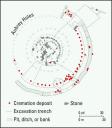A new study suggests that Stonehenge was first and foremost a burial ground, most likely for one highly prominent family.
The earliest cremation, a pile of burned bones and teeth, came from one of 56 pits called the Aubrey Holes.
These remains were dated to the monument’s first phase, when a circular bank and ditch were created on Salisbury Plain.
The second cremation, from inside the ditch surrounding Stonehenge, is said to be that of an adult buried between 2930 to 2870 B.C.
The latest burial studied, from the ditch’s northern side, was identified as that of a woman in her twenties. It dates to 2570 to 2340 B.C.—the period when the huge sandstone blocks known as sarsen stones were put up.
“We’re looking at a long-term use of the monument for burying the dead,” Parker Pearson said.
It’s estimated that up to 240 people are buried at Stonehenge in total, mainly in the Aubrey Holes. It is the largest known cemetery of its time in Britain.
 I had no idea there were so many people buried right in the thick of things at Stonehenge. Those fellows last month only referred to one body buried nearby as evidence for their Neolithic Lourdes theory.
I had no idea there were so many people buried right in the thick of things at Stonehenge. Those fellows last month only referred to one body buried nearby as evidence for their Neolithic Lourdes theory.
Instead, the place is ringed with burials (see the red spots on the map).
Not that the fact that there seems to have been some sort of dynastic burial situation going on before and while the stones went up necessarily conflicts with the healing temple idea. They just didn’t include that data in their PR materials.


